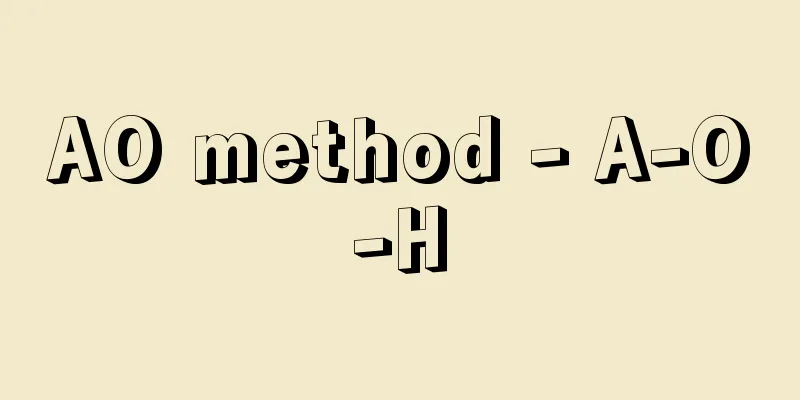Mankind - jinrui (English spelling) man

|
Humans are also called humans, but there are some differences in the nuance of how they are used. Taxonomically, they are animals that belong to the Hominidae family of the superfamily Homo (hominoids) of the order Primates. It is a general term for the same species as ourselves, but historically, the scope of the concept of humanity is quite arbitrary and expedient. In the hunter-gatherer era, when the population was extremely depopulated, there is evidence that only people in a small world centered around one's own tribe were considered to be human. At the time of Columbus's "discovery of the Americas," the conquerors did not consider the indigenous peoples to be human, as they did not accept the gospel of Christ, and repeatedly slaughtered and attacked them. Today, despite many differences in morphology and behavior, there is a general understanding that all human beings on Earth are a single species, and this is the basis for a sense of solidarity that we live in the same world. The species most closely related to humans are the various apes, and although they form the same family as us, the differences between the two in terms of morphology and behavior are clear. In general, humans are considered to be extremely unique among the animal kingdom, but there are many commonalities, and early humans in the fossil stage in particular have forms that are difficult to distinguish from apes. Today, anthropologists commonly understand that the basic condition for being human is upright bipedal walking (posture), but on the other hand, humans can also be defined as "animals with culture." [Shise Kahara] Effects of upright postureThe adoption of an upright posture occurred simultaneously with the differentiation of the limbs, i.e. the upper and lower limbs. The forward-moving posture with the torso upright is not seen in other animals and is mechanically unstable. For this reason, the pelvis becomes significantly wider and stronger, supporting the upper body. The lower limbs are longer than the upper limbs, with longer knees and longer thighs. Many mammals walk with only the tips of their toes or toes on the ground, but humans walk with the soles of their feet, including their heels, on the ground. Although our walking speed is slow, it is stable enough to walk on two legs. The feet themselves are long from front to back, and have arches that are made of bones, indicating that there are vertical and horizontal arches in the foot. These arches act as springs and make walking lighter. The spine is curved in an S-shape, preventing the shock of walking from being directly transmitted to the brain. The cross-section of the thorax is wider in width than in the front to back diameter. The shoulders are bulging out to the sides. Because the skull sits on top of the spine, unlike other animals, the foramen magnum is located in the center of the base of the skull and opens downwards. The trunk of most animals is normally nearly horizontal, with the face at its front end, but the trunk of humans, who stand upright, is vertical, with the face located at the front of the trunk at almost the top end. The internal organs of quadrupeds are aligned front to back, but the internal organs of humans standing upright are stacked one above the other, resulting in structural disorders such as gastroptosis. Problems such as wandering kidney, dizziness, hemorrhoids, lower back pain, and curvature can also be considered maladaptations to an upright posture. [Shise Kahara] Similarities with primatesHumans are a member of the primate family. Primates are generally not very specialized, but they have adapted to arboreal life, and our physical characteristics are similar. Opposable thumbs, which are found on the hands and feet of monkeys, are suitable for grasping branches. They disappear on the feet of humans, but the thumbs of the hands are developed and strong, and the other fingers move freely, making them suitable for using as tools. Both monkeys and humans have fingerprints on the tips of their fingers and toes, and their nails are flat, not hooked. Both eyes are lined up in front of the face, allowing stereoscopic vision and making it easy to estimate distances. Unlike other mammals, humans and monkeys have a poor sense of smell, but excellent color vision. Primates who live in forests do not have particularly good hearing, but human ears are dish-shaped and do not move. The facial expressions of higher apes are active due to their high intelligence, but those of humans are even more developed, with complex and subtle movements. Neither apes nor humans appear to have tails. Humans have a wide range of motion in the joints of their bodies, so they can bend and stretch their limbs well and show a variety of postures and gestures, which is an inheritance of the characteristics of monkeys who live in trees. [Shise Kahara] Characteristics of human evolutionA characteristic of human beings is that the canines became shorter and smaller, almost to the same extent as the other teeth, and their tips became rounded. They were no longer fangs, and the other teeth, especially the molars, also became smaller, the biting surface became simpler, the dentition changed from a U-shape to a parabolic shape, and the upper and lower jaws became smaller, resulting in a transition from a prognathic to a straight jaw. The regression of the masticatory apparatus is an important characteristic of human beings. As a result, the external nose protruded from the center of the face. The large brain, which many people consider to be the most important characteristic of human beings, is a continuation of the evolution of primates, and the brain size of early humans was about the same as that of gorillas, only about one-third that of modern humans. In the process of humanization, upright standing preceded a large brain. However, the fact that the brain increased threefold in the relatively short process of human evolution is significant. In particular, the frontal lobe of the cerebral hemisphere, which is related to abstract thinking, is thought to have increased significantly. This expansion of the brain is thought to be due to the development of motor functions, particularly in the hands and fingers, sensory functions, particularly in the visual sense, the acquisition of language abilities unique to humans, and increased mental activity, but on the other hand, it is believed that the shrinkage of the masticatory apparatus reduced the impact on the skull as a whole during chewing, which contributed to the expansion of the brain. As a result, a combination of a large braincase and a small facial cranium was created, forming the forehead. [Shise Kahara] Unique human characteristicsAlthough it is not possible to verify when this began, humans have very little body hair. Humans are active during the day, bathed in the tropical sunlight, but at the same time, having less body hair is advantageous for allowing their well-developed sweat glands to function fully. Having little facial hair also allows for a better expression of the face. Having thick scalp hair that is difficult to lose is ideal for protecting the well-developed head. Most of the sweat glands distributed in the human body are eccrine glands that secrete sweat with a weak odor, while apocrine glands that secrete strong-smelling sweat and are common in most mammals are limited to the armpits, genitals, etc. Other characteristics of humans that are unique in many ways include non-seasonal reproductive behavior, year-round reproduction, a long gestation period, immature newborns with very large brains, a wide birth canal and large pelvis in mothers capable of giving birth to babies with large brains, most births being singletons, a pair of breasts located high in the chest, a long period of nursing and nursing, a late onset of reproduction, continued survival after loss of reproductive ability, and a long lifespan compared to other animals. [Shise Kahara] Stages of human evolutionHuman evolution follows on from the evolution of primates. In the past, the age of humans was called the Quaternary Period, but as geological definitions changed and the nature of early humans became clear, the origin of humans came to be traced back to the end of the Pliocene epoch of the Tertiary Period. Many fossil apes have been named as the direct ancestors of humans. Around the 1970s, Ramapithecus was considered the most likely candidate based on its retracted teeth, but it was soon found to be similar to Sivapithecus, which followed a different path, and it disappeared. Today, there are no fossil apes that can be considered candidates for the direct ancestors of humans, but as a result of continued searches for older human fossils, all early human fossils have been unearthed in East Africa, and there is no disagreement that this is the birthplace of humans. Since then, the distribution area has expanded as time has passed, and human evolution has progressed. The evolutionary process is generally continuous and complex, but for the sake of overall understanding, it can be divided into four stages: ape-man → early man → archaic man → modern man. Ape-men are classified as australopithecines, except for Ardipithecus, which lived 4.4 million years ago. In order of age, the latter includes A. anamensis, A. afarensis, the slender A. africanus, and the sturdy A. aegypticus, A. robustus, and A. boisei. These existed in Africa between 4 million and 1 million years ago. The bridge between ape-men and early man is Homo habilis, and the particularly large one is now called Homo rudolfensis. It existed in East Africa 2.4 million to 1.7 million years ago. Early man, including Java man and Peking man, is unified as Homo erectus. It was widely distributed in the tropical and temperate zones of Afro-Eurasia between 1.8 million and 300,000 years ago. The older East African one is sometimes called Homo ergaster, and the newer European one is called Homo heidelbergensis. Archaic humans are called Neanderthals and archaic sapiens. They were widely distributed in the old continent 150,000 to 35,000 years ago, and some lived around glaciers during the glacial period. Modern humans are humans from 30,000 years ago to the present day, and include the Cro-Magnons in Europe, the mountaintop cave people in China, the Jomon period people in Japan, and modern humans. Today, they are distributed globally, except in areas with extremely harsh climates and barren lands. Archaic humans and modern humans are considered to be subspecies of Homo sapiens. As the evolutionary stage progresses, the face, which is the chewing organ, gradually shrinks and the brain grows larger. The size of the brain of early humans is about twice that of ape-men, and that of archaic humans and modern humans is about three times that of ape-men. There are various theories about the phylogenetic relationship of these various human species that spread across many regions. Some theories consider that they evolved monophyletically, ignoring minor differences, while others assume a complex phylogenetic relationship, and there is no consensus. However, the flow of human evolution is certainly established. This is of great significance in the intellectual world, since the theory of human evolution was denied or ignored in the 19th century. [Shise Kahara] Human evolution and cultureThe facts of human evolution cannot be explained by biological descriptions such as mere body shape and movement. Although the development of culture is not a biological phenomenon, it seems to have inherited human evolution. It is also culture that has promoted human evolution. The first example is the use and invention of tools. Most animals use their bodies to adapt to their living environment, but humans use things other than their own bodies, such as tools, stones, and wood, to deal with situations and adapt, and as a result, evolved. In this regard, the significance of human hands is extremely great. The use of tools and the use of fire greatly promoted the decline of the chewing organs. The use of language also strengthened social ties by making it easier to communicate one's thoughts to others, and expanded individual knowledge to social knowledge. The formation of this language was largely due to superior intelligence, but it should also be remembered that the mouth, pharynx, and larynx completed secondary functions as excellent vocalization organs. In addition, it should not be overlooked that many parts of the human body were suitable for accepting and developing culture. As humans evolved, their culture developed from hunting and gathering, through agriculture and animal husbandry, to industry and commerce, eventually creating modern people and modern culture. [Shise Kahara] Humanity from a cultural anthropological perspectiveBiologically, humans belong to the species Homo sapiens. When we trace the origins of humans back to ancient times, it becomes difficult to distinguish them from the ancestors of monkeys. It is generally accepted in academic circles that humans and monkeys evolved from the same ancestor. The question of where the differences lie between humans and other animals is a question of both physical anthropology and cultural anthropology. The theory that humans are social animals contains only partial truth, since there are other animals besides humans that form societies, such as ants and bees. In the end, no one questions the theory that the fundamental characteristic that distinguishes humans from animals is the use of language. According to Leslie White, the ability to speak is something that only humans possess. According to White, this is the "function of symbolization." In other words, it is the ability to give meaning to something. Just as a dog can learn the words "hold" and "shake," animals can learn the meaning of sounds to a certain extent through conditioning. However, animals do not have the ability to give meaning to something, that is, to "symbolize." It is this ability to "symbolize," which is unique to humans, that has created language and given rise to culture. So, did humans develop language and culture after first being genetically equipped with the ability to symbolize? The oldest fossil human, the "ape-man," walked upright, made tools from antelope and whale bones, and made rough stone tools, so it seems that he had a simple, primitive culture. As cultural anthropologist Clifford Geertz has stated, "If Australopithecus (ape-man) had a primitive form of culture, even though their brains were only one-third the size of modern humans, the expansion of the human cerebral cortex must have occurred after, not prior to, the beginning of culture," so it would be more appropriate to think that humans' ability to symbolize was not created before the emergence of culture, but was developed along with the development of culture. Physical anthropologist Washburne also says, "Rather than thinking of humans with anatomical bodies similar to ours gradually discovering culture, it is probably more accurate to think of many of our structures as the result of the existence of culture." As mentioned above, all people currently living on Earth belong to one "species," but there is often a mistaken belief that racial differences within humanity reflect differences in genetic superiority or inferiority, and there has long been a prejudice that Western races are superior and a tendency to look down on other races. In Western Europe particularly in the 19th century, the view that Western civilization is the pinnacle and that all non-Western cultures are inferior was systematized academically, and cultural evolutionism, which holds that culture evolves in a linear manner, emerged. Since the Meiji era, in the process of introducing Western sciences into Japan, it has consciously or unconsciously accepted the Western theory of linear cultural evolution. However, as research progressed, it became clear that the cultures of so-called primitive peoples had also developed to some extent, and it was also demonstrated that cultures do not necessarily evolve in a straight line. People began to advocate cultural relativism, which says that standards of right and wrong, good and bad, differ depending on each culture, and to avoid measuring the cultures of other peoples by the yardstick of one's own country's value judgments. It is true that we are superior to so-called primitive peoples in terms of technology, but it has become clear that it is not only difficult but also inappropriate to judge superiority or inferiority in terms of customs and habits. Humans are broadly classified into three groups based on their characteristics: white, yellow, and black. However, there is no data to show that there are any innate or genetic differences in intelligence between the races. We must not forget that erroneous racial views and racism have caused many tragic events throughout history. The concept of race is a purely biological concept, and differences in customs and habits, or more broadly, differences in culture, are not directly related to differences in race. People of the same race who grow up in different cultures will have completely different cultures, and people of different races who grow up in the same culture will have the same culture. Human culture is diverse, and according to Murdoch, there are at least 3,000 individual cultures of ethnic groups and nations on Earth. Although culture is diverse, there are also similarities. Among these, the common biological condition of humankind cannot be ignored. In addition, structural anthropology in France is promoting the exploration of the universal "human spirit" and ways of thinking that are not tainted by the scientific and technological civilization of the West. Cultural anthropological research on humanity should pay attention to cultural similarities as well as cultural diversity. [Teigo Yoshida] "Anthropology Lectures, 13 volumes and 3 supplementary volumes, compiled by the Anthropology Lectures Editorial Committee (1977-2001, Yuzankaku)" ▽ "Introduction to Cultural Anthropology, by Sobue Takao (Chuko Shinsho)" ▽ "Exploring Primitive Tribes, by Yoshida Teigo (Shakai Shisosha, Gendai Kyoyo Bunko)" ▽ "Invitation to Cultural Anthropology, by Yamaguchi Masao (Iwanami Shinsho)" ©Shogakukan ©Masazumi Fujita "> Correlation diagram between uprightness and human characteristics "Lucy" (Australopithecus afarensis) Late Pliocene period, Neogene period, Cenozoic Era, excavated from Hadar, Ethiopia, Photo/Fukui Prefectural Dinosaur Museum Image Library "> Australopithecus fossil bones Cenozoic Quaternary Pleistocene Photo from Zhoukoudian Excavation Site, Beijing, China / Fukui Prefectural Dinosaur Museum Image Library "> Mountaintop Cave Man Skull Source: Shogakukan Encyclopedia Nipponica About Encyclopedia Nipponica Information | Legend |
|
ヒト、人間ともいうが、用い方に若干のニュアンスの差がある。分類学的には霊長目のヒト(類人類)上科のヒト科に属する動物。われわれ自身と同類の総称であるが、歴史的にみれば、人類という概念の範囲はかなり恣意(しい)的、便宜的である。超過疎であった採集狩猟時代では、自部族中心の狭い世界の者のみを人類とみなしていた形跡がある。コロンブスによる「アメリカ大陸発見」当時、征服者たちは先住民をキリストの福音(ふくいん)を受けない者として、人類とみなさず、殺戮劫略(さつりくごうりゃく)を繰り返した。今日では、形態・行動上、多くの差異がありながら、地球上各地の人類はすべて単一種であるという一般的認識があり、それは同一世界に生きているという連帯感の基礎となっている。人類にもっとも近縁の種は類人猿各種であり、これらとは同じヒト上科をつくるが、形態・行動の点で両者の差は歴然としている。一般に人類は動物界のなかでもきわめて独自のものとされているが、共通する点も多々あり、とくに化石段階の初期人類は類人猿と区別しにくい形態をもつ。今日、人類学者たちの共通の理解では、人類である基本的条件は直立二足歩行(姿勢)であるが、他方「文化をもつ動物」として人類を規定することもできる。 [香原志勢] 直立姿勢の影響直立姿勢の採用は、手足、すなわち上下肢の分化と同時進行した。胴体を直立させての前進姿勢は、他の動物にはみられず、力学的にも不安定である。このため骨盤は著しく幅広く、強大化し、上半身を担う。下肢は上肢より長く、膝(ひざ)が伸び、大腿(だいたい)も長くなる。多くの哺乳(ほにゅう)類は指先、つまさきのみを地につけて歩くが、人類はかかとを含め足底をつけて歩く。歩行速度は遅いが、二本足で歩くには安定する。足自体は前後に長く、土ふまずがみられるが、これは足部内に骨からなる縦・横のアーチがあることを示す。このアーチがばねとなり、歩行を軽やかにする。脊柱(せきちゅう)はS字状に彎曲(わんきょく)し、歩行時の衝撃が脳に直接伝わることを防ぐ。胸部横断面は前後径より横幅のほうが広い。肩は側方に張る。頭蓋(とうがい)は脊柱の上にのるため、他の動物と異なり、大後頭孔(だいこうとうこう)は頭蓋底の中央部にあって下方に向かい開口する。一般の動物の体幹は平生はほぼ水平であり、その前端が顔となるが、直立姿勢をとる人類の体幹は垂直であり、そのほぼ上端の前面に顔がくる。四足動物の内臓諸器官は前後に並ぶが、直立した人類の内臓は上下に重積するため、胃下垂のような構造的な疾患が生じる。遊走腎(じん)、めまい、痔疾(じしつ)、腰痛(ようつう)、背曲がりなどの障害も、直立姿勢に対する不適応現象といえる。 [香原志勢] 霊長類との共通点人類は霊長類の一員である。霊長類は全体として特殊化の程度が弱いが、樹上生活に対して適応し、人類の身体特徴もこれに準じる。母指(おやゆび)が他の4本の指と向かい合う母指対向性は、サルでは手足にみられ、枝を握るのに適している。人類の足ではそれは消失するが、手の母指は発達し、強大になり、またほかの指も自在に動き、道具扱いに適する。サルも人類も手足の指先に指紋をもち、爪(つめ)は鉤(かぎ)状でなく、扁(ひら)爪である。両眼は顔の前面に並ぶため、立体視が可能となり、距離の目測に都合がよい。一般哺乳類と異なり、人類とサルの嗅覚(きゅうかく)は鈍いが、色覚に優れる。森林にすむ霊長類の聴覚は格別優れてはいないが、人類の耳介(じかい)は皿状で、また動かない。高等猿類の表情は、知能が高いこともあって動きが活発であるが、人類のそれは一段と発達し、複雑かつ微妙に動く。類人猿も人類も外見上、尾はない。人類の身体は諸関節の可動範囲が広いため、肢体がよく屈伸し、さまざまな姿勢、手ぶりを示すことができるが、それは樹上生活をするサルの特質を受け継いだものである。 [香原志勢] 人類進化の特徴人類の特色として、犬歯がほかの歯とほぼ同じ程度に短小化し、その先端が丸くなる。それは牙(きば)ではなくなり、その他の歯、とくに大臼歯(きゅうし)も小さくなり、咬面(こうめん)も単純化し、歯列がU字形から放物線状に変じ、上下顎骨(がくこつ)は縮小し、結果として、突顎から直顎へ移行する。そしゃく器の退縮は人類の重要な特徴である。それに伴って外鼻は顔面中央部に突出した。人類の最主要な特色と多くの人がみなす大きな脳は、霊長類の進化を引き継ぐものであり、初期人類の脳の大きさはゴリラ程度で、現生人類の約3分の1にすぎない。人類化への過程においては、大きな脳より、直立が先行する。しかし、比較的短い人類進化の過程に脳が3倍に増えたことは大きな意味をもつ。とくに大脳半球のうち、抽象的思考と関連ある前頭葉は著しく増大したとみられる。このような脳の拡大は、手指をはじめとする運動機能や視覚を中心とする感覚機能の発達、人類独自の言語能力の獲得、精神活動の活発化などによると考えられるが、一方、そしゃく器の退縮に伴い、そしゃく時の頭骨全体への衝撃が小さくなり、そのことが脳の増大に資したとみられている。結果として、大きい脳頭蓋と小さい顔面頭蓋という組合せを生み、額が形成される。 [香原志勢] 人類独特の特徴いつの時代に始まったか検証できないが、人類の体毛は非常に少ない。人類は熱帯の日光を浴びつつ、日中活動するが、一方、発達した汗腺(かんせん)を十分に機能させるためには、体毛の少ないほうが有利である。また顔毛の少ないのは、顔の表情をよく表す。頭髪が密なうえ、脱毛しにくいのは、発達した頭部の保護に適する。人体に分布する汗腺の多くは臭(にお)いの弱い汗を分泌するエクリン腺であり、一般哺乳類に普遍的な、臭いの強い汗を分泌するアポクリン腺は腋窩(えきか)、陰部などに限られる。その他の人類の特色として、生殖行動が季節性をもたず、年中可能なこと、長い受胎期間、きわめて大きな脳をもちながら未熟な新生児、大きな脳をもつ子を分娩(ぶんべん)しうる母体の広い産道と大きい骨盤、多くの場合単胎であること、胸部上方にある1対の乳房、哺乳・育児期間が長いこと、生殖開始期が遅いこと、生殖能力喪失後も生存し続けること、そして、ほかの動物と比べても長命なことなど、多くの点で人類独特のものがある。 [香原志勢] 人類進化の諸段階人類進化は霊長類の進化を引き継ぐ。かつては人類の時代をもって第四紀とよんだが、地質学上の定義が変わり、また初期人類の実態が明らかになるにつれ、人類の発祥は第三紀鮮新世末にさかのぼることになった。人類の直接的祖先としてこれまで多くの化石類人猿の名があがった。歯の退縮を根拠に1970年代前後にはラマピテクスが有力視されたが、やがて別の道を歩むシバピテクスとの類縁性が指摘され、消えた。今日人類の直系祖先の候補者の座を占める化石類人猿はいないが、より古い人類化石の探索が続けられた結果、初期人類化石はすべて東アフリカから出土しており、同地こそ人類発祥の地とする見方に異論はない。以後時代が下るにつれその分布域は広がり、人類進化も進行した。その進化過程はおおむね連続的で複雑だが、全体的理解の便のため、猿人→原人→旧人→新人という4段階に分けられる。猿人は440万年前のアルディピテクス以外は、アウストラロピテクス類である。古いものからあげると、後者にはA. アナメンシス、A. アファレンシス、きゃしゃなA. アフリカヌス、そしていずれも頑丈なA. エジプティクス、A. ロブストゥス、A. ボイセイが入る。これらは400万年前から100万年前にアフリカに存在した。猿人と原人の橋渡しをするのが、ホモ・ハビリスで、とくに大型のものは最近はホモ・ルドルフェンシスとよばれる。240万~170万年前東アフリカに存在した。原人はジャワ原人や北京(ペキン)原人を含めて、ホモ・エレクトゥスで統一される。180万~30万年前アフロ・ユーラシアの熱帯、温帯に広く分布した。なお古い東アフリカのものをホモ・エルガステル、新しいヨーロッパのものをホモ・ハイデルベルゲンシスとよぶこともある。旧人はネアンデルタール人および古代型サピエンスという。15万~3万5000年前に旧大陸に広く分布し、氷期には氷河周辺にからくも居住するものがいた。新人は3万年前から今日に至るまでの人類で、ヨーロッパのクロマニョン人、中国の山頂洞人、日本の縄文時代人、そして現代人などはこれに属する。今日では極度に過酷な気候で不毛な土地を除き、汎(はん)地球的に分布する。旧人と新人はホモ・サピエンスのなかの亜種関係とみられている。進化段階が進むにあたり、しだいに、そしゃく器である顔面が退縮すると同時に、脳は大きくなる。原人の脳の大きさは猿人のそれの約2倍、旧人と新人は約3倍となる。多地域にもわたったこれらの諸人類の系統関係には諸説があり、小異を捨てて単系進化をしたとみる説がある一方、複雑な系統関係で想定する説もあり、定説はない。しかし、人類進化の流れは確実に定まっている。そのことは、19世紀には人類進化説が否定、もしくは無視されていただけに、思想界としてはきわめて重要な意味をもつ。 [香原志勢] 人類進化と文化人類進化の事実は、単なる身体の形や動きなど生物学的叙述だけでは説明できない。文化の発達は生物学的現象ではないが、人類進化を引き継いでいるようにみえる。また人類進化を促進したのが文化である。それとしてまずあげられるのが道具の使用・発明である。一般の動物は身体を用いて生存環境に適応するが、人類は自分の身体以外のもの、すなわち道具、あるいは石や木などを用いて事態を処理して適応し、結果として進化した。その際、人類の手の意義はきわめて大きい。道具の使用および火の利用はそしゃく器の退縮を大いに促した。また言語の使用は、自分の思いを容易に他者に伝達することにより、社会的紐帯(ちゅうたい)を強め、個人の知識を社会の知識にまで広げた。この言語の成立は優れた知能によるところが大きいが、一方、口、咽頭(いんとう)、喉頭(こうとう)が優れた発声器官として副次機能を完成させたことも銘記すべきである。そのほか、人類の身体の多くの部分が、文化を受け入れ、発展させるのに適していたことも見逃せない。人類進化に伴って、その文化は採集狩猟、農耕牧畜を経て工業・商業へと発展し、現代人と現代文化をつくるに至った。 [香原志勢] 文化人類学からみた人類人類は生物学的にはホモ・サピエンスという種に属している。人類の祖先を昔にさかのぼっていくと、猿の祖先との区別が困難になる。人類と猿は同じ祖先から進化してきたということは学界で一般に受け入れられている。そこで人類と他の動物との違いはどこにあるかという問題は、形質人類学の問題であるとともに、文化人類学の問題でもある。人類は社会的動物であるという説は、アリやミツバチのように、社会をつくる動物は人間以外にもあるところから、部分的な真理しか含まないことがわかる。結局のところ、人類と動物を区別する根本的な特色は言語の使用という点にあるという説に疑問を挟む者はいない。 言語能力は、レズリー・ホワイトによると、人類のみが所有するものである。これは、ホワイトによると「象徴化の機能」である。いいかえれば、あるものに意味を与える能力である。犬が「おあずけ」や「お手」を覚えるように、動物でも条件づけによって、音声の意味をある程度習得することができるが、動物は、あるものに意味を与えること、つまり「象徴化」の能力をもっていないのである。この人類に特有の「象徴化」の能力こそ言語をつくりだし、文化を生み出したというのである。 それでは、人類は形質的に象徴化の能力をまず十分に備えたうえで、言語や文化をつくりだしたのだろうか。最古の化石人類「猿人」は直立歩行しており、カモシカやクジラの骨から道具をつくり、荒削りの石器をつくっていたところからすると、素朴な原初的な文化をもっていたと思われる。文化人類学者クリフォード・ギアツが、「アウストラロピテクス(猿人)が、いまの人間のわずか3分の1の大きさの頭脳しかもたないのに、文化の原初形態をもっていたとすれば、人間の大脳皮質が拡大したのは、文化の開始に先行したのではなく、それに後続しておこった」のであろうと述べているように、人類の象徴化の能力は、文化の発生前につくられたのではなく、文化の発展に伴って育成されてきたと考えるほうが適当であろう。形質人類学者ウォッシュバーンも、「解剖学的にわれわれと等しいからだをもった人間が、ゆっくりと文化を発見していったと考えるよりも、われわれの(身体的)構造の多くは、文化が存在したことの結果であると考えるほうがおそらく正しい」といっている。 現在地球上に住むあらゆる人々は、前述のように一つの「種」に属しているが、人類のなかの人種の違いが遺伝的な優劣の違いを現すのではないかという誤った考え方がしばしばみられるし、西欧民族がもっとも優れているという偏見や、他民族を蔑視(べっし)する傾向も古くからある。とくに19世紀の西欧において、西欧文明を頂点とし、西欧以外の文化をすべてこれより劣ったものとみる見解は学問的に体系化され、文化は直線的に進化するという文化進化主義が登場した。明治以来、日本が西欧の諸科学を導入する過程において、意識的あるいは無意識的に、西欧の直線的文化進化論も受け入れてきた。 ところが、研究が進むにつれて、いわゆる未開民族の文化もそれなりに発展してきていることがわかり、しかも文化はかならずしも一直線には進化しないことも実証されるようになった。自分の国の価値判断の物差しで他の民族の文化を計ることを避け、正邪・善悪の規準はそれぞれの文化に応じて異なるという文化相対主義が主張されるようになった。確かに技術の面ではわれわれのほうがいわゆる未開人よりも優れているが、風俗習慣について優劣を決めることは困難であるだけでなく、不適切であることがわかってきた。 人類は、形質的に、白人種群、黄色人種群、黒人種群に大きく分類されるが、人種間に先天的、遺伝的な知能差が存在することを示すデータは何もないのである。誤った人種観、人種主義racismが歴史上数々の悲惨なできごとを生んできたことを忘れてはならない。 人種という概念は純粋に生物学的概念であって、風俗習慣の違いやもっと広く文化の違いは、人種の違いとは直接関係がない。同じ人種の人々も異なる文化に成長すれば、まったく異なる文化を担うようになり、異なる人種の者でも同じ文化に育てば、同じ文化をもつようになる。人類の文化は多様で、地球上の民族や国民のもつ個別的文化は、マードックによれば少なくとも3000以上ある。文化は多様であるが、その反面に類似性も存在する。そのなかには、人類のもつ共通の生物学的条件という要因を無視することはできない。また、西欧の科学技術文明に染まらない人類普遍の「人間精神」、思考様式の探究がフランスの構造人類学によって推進されている。人類の文化人類学的研究は、文化の多様性とともに文化の類似性にも注目すべきであろう。 [吉田禎吾] 『人類学講座編纂委員会編『人類学講座』全13巻・別巻3(1977~2001・雄山閣)』▽『祖父江孝男著『文化人類学入門』(中公新書)』▽『吉田禎吾著『未開民族を探る』(社会思想社・現代教養文庫)』▽『山口昌男著『文化人類学への招待』(岩波新書)』 ©Shogakukan ©藤田正純"> 直立と人類の諸特徴との相関図 "Lucy"(アウストラロピテクス・アファレンシス〈ルーシー〉) 新生代新第三紀鮮新世後期 エチオピア ハダール出土写真/福井県立恐竜博物館画像ライブラリー"> アウストラロピテクスの化石骨 新生代第四紀更新世 中国 北京 周口店出土写真/福井県立恐竜博物館画像ライブラリー"> 山頂洞人の頭骨 出典 小学館 日本大百科全書(ニッポニカ)日本大百科全書(ニッポニカ)について 情報 | 凡例 |
Recommend
Cardiocrinum cordatum var.cordatum (English spelling) Cardiocrinumcordatumvarcordatum
…[Tetsuichi Yahara]. … *Some of the terminology t...
Kayahara Kazan
A journalist and critic. His real name was Rentar...
Daikonsou - Daikonsou
...However, the whole plant is sometimes used in ...
Losbanosia hibarensis (English spelling)
...Adults often fly to lights. In Japan, 12 speci...
"Blind in Gaza" - Gaza ni meshiite
…He published “Amor Counterpoint” (1928), an inte...
Eilat Incident
... refers to a relatively small warship equipped...
Stoichiometric equation - kagakuryorontekihoteishiki
…This idea was passed down to the founders of mod...
Sir Herbert Read
Born: December 4, 1893, Kirkby Moorside, Yorkshire...
Akauo (redfish) - Akauo
...Its name is Akamutsu because of its red body c...
Masashi Aizawa - Masashi Aizawa
A Confucian scholar from the late Edo period and ...
Paul Gauguin
French Post-Impressionist painter. Starting from ...
Abortion - ninshinchuzetsu
Abortion is divided into spontaneous and induced ...
Pleuronectidae
…General term for fish in the family Pleuronectid...
Ermetismo - Ermetismo (English spelling)
This school of poetry dominated Italian poetry af...
job description
… The information items obtained are: (1) the cre...









